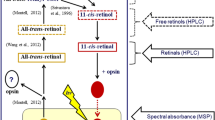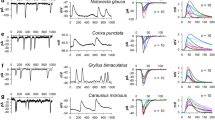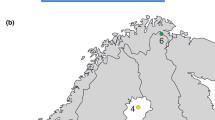Summary
-
1.
Effects of light and dark adaptation on the photoreceptor membranes of the rock crabGrapsus have been quantitatively studied using light and electron microscopy to document changes in rhabdom size and their fine structural basis. Some comparative data were also obtained for the ghost crabOcypode. Animals in the laboratory were maintained on a daily light (L)-dark (D)cycle 12L∶12D. Periods of adaptation ranged from 3–28 h (Table 1) and light adaptation was effected at one moderate intensity equal to the light period in the daily sequence.
-
2.
Massive rapid reversible changes in rhabdom size (Fig. 1) comprising mainly diameter modulation (Figs. 2, 3) and some alteration in length, normally resulted in maximum increases in receptor organelle volume of about 20× between a thinner, shorter fully light adapted condition (2×290 μm) to the fully dark adapted state (7.9× 336 μm).
-
3.
Rhabdom growth during dark adaptation (Table 2) was due mainly (Fig. 8) to microvillus elongation (+154%) as well as substantial increase (+117%) in the number of microvilli present in cross sections (Figs. 2, 3, 10); microvillus diameter (Figs. 4, 5, 9) also increased (+14%) but accounts for only a minor part of the overall change commensurate with observed differences in rhabdom length (+16%). Calculation shows that from fully light adapted to fully dark adapted state the area of photoreceptor membrane increased nearly 20× in a few hours.
-
4.
Although duration of adaptation affected its amplitude, six hours of either light or darkness evoked the maximum changes documented; shorter and longer periods had less effect (Figs. 6, 7).
-
5.
Time of day had a strong periodic influence on the amplitude of membrane adaptation produced by a given exposure to dark or light. Thus maximum dark adaptation occurred with 6 h of darkness terminating at midnight and maximum light adaptation with 6 h of light ending at noon of the diurnal light cycle (Fig. 11).
-
6.
Direct effects of light and dark on synthesis and degradation of photoreceptor membrane must therefore be superimposed on indirect or direct cyclic neuroendocrine control presumably coupled to an entrained circadian oscillator.
Similar content being viewed by others
References
Ali, M. (ed.): Vision in fishes. NATO Advanced Study Institute Series: Life Sciences, Vol. 1., pp. 836. New York: Plenum Publishing Corporation 1975
Anderson, D.H., Fisher, S.K.: The photoreceptors of diurnal squirrels: outer segment structure, disc shedding and protein renewal. J. Ultrastruct. Res.55, 119–141 (1976)
Anderson, D.H., Fisher, S.K., Steinberg, R.H.: Mammalian cones — disc shedding, phagocytosis, and renewal. Invest. Ophthalmol.17, 117–133 (1978)
Arechiga, H.: Circadian rhythmicity in the nervous system of crustaceans. Fed. Proc.36, 2036–2041 (1977)
Axelrod, J.: The pineal gland: a neurochemical transducer. Science184, 1341–1348 (1974)
Bagnara, J.T.: Pineal regulation of the body lightening reaction in amphibian larvae. Science132, 1481–1483 (1960)
Barlow, R.B., Jr., Bolonowski, S.J., Jr., Brachman, M.L.: Efferent optic nerve fibers mediate circadian rhythms in theLimulus eye. Science197, 86–89 (1977)
Barnes, S.N., Goldsmith, T.H.: Dark adaptation, sensitivity and rhodopsin level in the eye of the lobster,Homarus. J. Comp. Physiol.120, 143–159 (1977)
Basinger, S., Hoffman, R., Mathes, M.: Photoreceptor shedding is initiated by light in the frog retina. Science194, 1074–1076 (1976)
Bedini, C., Ferrero, E., Lanfranchi, A.: Fine structural changes induced by circadian light-dark cycles in photoreceptors of Dalyelliidae (Turbellaria: Rhabdocoela). J. Ultrastruct. Res.58, 66–77 (1977)
Binkley, S.: Pineal gland biorhythms:N-acetyltransferase in chickens and rats. Fed. Proc.35, 2347–2352 (1976)
Birch, D., Jacobs, G.H.: Effects of constant illumination on vision in the albino rat. Physiol. Behav.19, 255–259 (1977)
Blest, A.D.: The rapid synthesis and destruction of photoreceptor membrane by a dinopid spider; a daily cycle. Proc. R, Soc. London (Biol.)200, 463–483 (1978)
Blest, A.D., Day, W.A.: The rhabdomere organization of some nocturnal Pisaurid spiders in light and darkness. Phil. Trans. R. Soc. London (Biol.)283, 1–23 (1978)
Blest, A.D., Powell, K., Kao, L.: Photoreceptor membrane breakdown in the spiderDinopis: GERL differentiation in the receptors. Cell Tiss. Res.195, 277–297 (1978)
Bok, D., Hall, M.O., O'Brien, P.: The biosynthesis of rhodopsin as studied by membrane renewal in rod outer segments. In: International cell biology. Brinkley, B.R., Porter, K.R. (eds.), pp. 608–617. New York: Rockefeller University Press 1977
Brady, J.: The physiology of insect circadian rhythms. Adv. Insect Physiol.10, 1–115 (1974)
Brammer, J.D., Clarin, B.: Changes in volume of the rhabdom in the compound eye ofAedes aegypti L. J. Exp. Zool.195, 33–40 (1976)
Bridges, C.D.B., Hollyfield, J.G., Besharse, J.C., Rayborn, M.E.: Visual pigment loss after light induced shedding of rod outer segments. Exp. Eye Res.23, 637–641 (1976)
Brodie, A.E., Bownds, D.: Biochemical correlates of adaptation processes in isolated frog photoreceptor membranes. J. Gen. Physiol.68, 1–11 (1976)
Brown, F.A., Jr.: Physiological rhythms. In: The physiology of Crustacea, Vol. II. Waterman, T.H. (ed.), pp. 401–430. New York: Academic Press 1961
Burnside, B.: Thin (actin) and thick (myosinlike) filaments in cone contraction in the teleost retina. J. Cell Biol.78, 227–246 (1978)
Currie, J.R., Hollyfield, J.G., Rayborn, M.E.: Rod outer segment elongation in constant light: darkness is required for normal shedding. Vision Res.18, 995–1003 (1978)
Dartnall, H.J.A.: Photosensitivity. In: Handbook of sensory physiology, Vol. VII/1. Dartnall, H.J.A. (ed.), pp. 122–145. Berlin, Heidelberg, New York: Springer 1972
Debaisieux, P.: Les yeux des Crustacés. Cellule50, 9–122 (1944)
Dembowski, I.: Über den Bau der Augen vonOcypode ceratophthalma Fabr. Zool. Jahrb. Abt. Anat. Ontog. Tiere36, 513–524 (1913)
Dodt, E.: The parietal eye (pineal and parietal organs) of lower vertebrates. In: Handbook of sensory physiology, Vol. VII/3B. Jung, R. (ed.), pp. 113–140. Berlin, Heidelberg, New York: Springer 1973
Eakin, R.M.: The third eye. pp. 157. Berkeley: University of California Press 1973
Eguchi, E.: Rhabdom structure and receptor potentials in single crayfish retinular cells. J. Cell. Comp. Physiol.66, 411–429 (1965)
Eguchi, E., Waterman, T.H.: Fine structure patterns in crustacean rhabdoms. In: The functional organization of the compound eye. Bernhard, C.G. (ed.), pp. 105–124. Oxford: Pergamon Press 1966
Eguchi, E., Waterman, T.H.: Changes in retinal fine structure induced in the crabLibinia by light and dark adaptation. Z. Zellforsch.79, 209–229 (1967)
Eguchi, E., Waterman, T.H.: Cellular basis for polarized light perception in the spider crab,Libinia. Z. Zellforsch.84, 87–101 (1968)
Eguchi, E., Waterman, T.H.: Orthogonal microvillus pattern in the eighth rhabdomere of the rock crabGrapsus. Z. Zellforsch.137, 145–157 (1973)
Eguchi, E., Waterman, T.H.: Freeze-etch and histochemical evidence for cycling in crayfish photoreceptor membranes. Cell Tiss. Res.169, 419–434 (1976)
Eguchi, E., Waterman, T.H.: Longterm dark induced fine structural changes in crayfish photoreceptor membrane. J. Comp. Physiol.131, 191–203 (1979)
Eguchi, E., Waterman, T.H., Akiyama, J.: Localization of the violet and yellow receptor cells in the crayfish retinula. J. Gen. Physiol.62, 355–374 (1973)
Elliott, J.A.: Circadian rhythms and photoperiodic time measurement in mammals. Fed. Proc.35, 2339–2346 (1976)
Goldsmith, T.H.: The effects of screening pigments on the spectral sensitivity of some Crustacea with scotopic (superposition) eyes. Vision Res.18, 475–482 (1978)
Hamasaki, D.I., Eder, D.J.: Adaptive radiation of the pineal system. In: Handbook of sensory physiology, Vol. VII/5. Crescitelli, F. (ed.), pp. 497–548. Berlin, Heidelberg, New York: Springer 1977
Hollyfield, J.G., Basinger. S.F.: Cyclic metabolism of photoreceptor cells. Invest. Ophthalmol.17, 87–89 (1978a)
Hollyfield, J.G., Basinger, S.F.: Photoreceptor shedding can be initiated within the eye. Nature274, 794–796 (1978b)
Itaya, S.K.: Rhabdom changes in the shrimpPalaemonetes. Cell Tiss. Res.166, 256–273 (1976)
Jacklet, W.: Neuronal circadian rhythm: phase shifting by a protein synthesis inhibitor. Science198, 69–70 (1977)
Karnovsky, M.J.: A formaldehyde-glutaraldehyde fixative of high osmolarity for use in electron microscopy. J. Cell Biol.27, 137A-138A (1965)
Kleinholz, L.H.: Eye-stalk hormone and the movement of the distal retinal pigment inPalaemonetes. Proc. Natl. Acad. Sci. U.S.A.20, 659–661 (1934)
Kleinholz, L.H.: Pigmentary effectors. In: The physiology of Crustacea, Vol. II. Waterman, T.H. (ed.), pp. 133–169. New York: Academic Press 1961
Kong, K.-L., Goldsmith, T.H.: Photosensitivity of retinular cells in white-eyed crayfish (Procambarus clarkii). J. Comp. Physiol.122, 273–288 (1977)
Kunze, P.: Histologische Untersuchungen zum Bau des Auges vonOcypode cursor (Brachyura). Z. Zellforsch.82, 466–478 (1967)
Kunze, P., Boschek, C.B.: Elektronenmikroskopische Untersuchung zur Form der achten Retinulazelle beiOcypode. Z. Naturforsch.23b, 568b-569b (1968)
LaVail, M.M.: Rod outer segment disk shedding in rat retina; relationship to cyclic lighting. Science194, 1071–1073 (1976a)
LaVail, M.M.: Rod outer segment disc shedding in relation to cyclic lighting. Exp. Eye Res.23, 277–280 (1976b)
Lipton, S.A., Ostroy, S.E., Dowling, J.E.: Electrical and adaptive properties of rod photoreceptors inBufo marinus. I. Effects of altered extracellular Ca2+ levels. J. Gen. Physiol.70, 747–771 (1977a)
Lipton, S.A., Rasmussen, H., Dowling, J.E.: Electrical and adaptive properties of rod photoreceptors inBufo marinus. II. Effects of cyclic nucleotides and prostaglandins. J. Gen. Physiol.70, 771–791 (1977b)
Loew, E.R.: Light, and photoreceptor degeneration in the Norway lobster,Nephrops norvegicus (L.) Proc. R. Soc. London (Biol.)193, 31–14 (1976)
Ludolph, C., Pagnanelli, D., Mote, M.I.: Neural control of migration of proximal screening pigment by retinular cells of the swimming crabCallinectes sapidus. Biol. Bull.145, 159–170 (1973)
Mansfield, R.J.W.: Visual adaptation: retinal transduction, brightness and sensitivity. Vision Res.16, 679–690 (1976)
Meyer, D.B.: The avian eye and its adaptations. In: Handbook of sensory physiology, Vol. VII/5. Crescitelli, F. (ed.), pp. 549–611. Berlin, Heidelberg, New York: Springer 1977
Meyer-Rochow, V.B., Horridge, G.A.: The eye ofAnoplognathus (Coleoptera, Scarabaeidae). Proc. R. Soc. London (Biol.)188, 1–30 (1975)
Miller, W.H.: Ocular optical filtering. In: Handbook of sensory physiology, Vol. VII/ 6A. Autrum, H. (ed.). Berlin, Heidelberg, New York: Springer (in press) 1979
Nemanic, P.: Fine structure of the compound eye ofPorcellio scaber in light and dark adaptation. Tissue Cell7, 453–468 (1975)
O'Day, W.T., Young, R.W.: Rhythmic daily shedding of outer-segment membranes by visual cells in the goldfish. J. Cell Biol.76, 593–604 (1978)
Olivo, R.F., Larsen, M.E.: Brief exposure to light initiates screening pigment migration in retinula cells of the crayfishProcambarus. J. Comp. Physiol.125, 91–96 (1978)
Page, T.L., Larimer, J.L.: Neural control of circadian rhythmicity in crayfish. 2. ERG amplitude rhythm. J. Comp. Physiol.97, 81–96 (1975)
Page, T.L., Larimer, J.L.: Extraretinal photoreception in entrain-ment of crustacean circadian rhythm. Photochem. Photobiol.23, 245–251 (1976)
Papermaster, D.S., Schneider, B.G., Zorn, M.A., Kraehenbuhl, J.P.: Immunocytochemical localization of opsin in outer segments and Golgi zones of frog photoreceptor cells. J. Cell Biol.77, 196–210 (1978)
Rapp, L.M., Williams, T.F.: Rhodopsin content and electroretino-graphic sensitivity in light damaged rat retina. Nature267, 835–836 (1977)
Röhlich, P.: Fine structural changes induced in photoreceptors by light and prolonged darkness. In: Symposium on neurobiol-ogy of invertebrates, Tihany, Hungary, 1967. Salanki, J. (ed.). pp. 95–109. New York: Plenum Press 1968
Rosenkranz, J.: New aspects of the ultrastructure of frog rod outer segments. In: International review of cytology. Bourne, G.H., Danielli, J.F. (eds.), pp. 26–158. New York: Academic Press 1977
Sanchez, J.A., Fuentes-Pardo, B.: Circadian rhythm in the amplitude of the electroretinogram in the isolated eyestalk of the crayfish. Comp. Biochem. Physiol.56, 601–605 (1977)
Sato, S.: Compound eyes ofCulex pipiens vat. pallens Coquillett. (Morphological studies on the compound eye in the mosquito, No. 1.) Sci. Rep. Tôhoku Univ.18, 331–341 (1950)
Sato, S., Kato, M., Toriumi, M.: Structural changes of the compound eye ofCulex pipiens vat. pallens Coquillett in the process to dark adaptation. Sci. Rep. Tôhoku Univ.23, 91–101 (1957)
Smith, R.I.: The role of the sinus glands in retinal pigment migration in grapsoid crabs. Biol. Bull.95, 169–185 (1948)
Strong, J., Lisman, J.: Initiation of light adaptation in barnacle photoreceptors. Science200, 1485–1487 (1978)
Tamai, M., Tierstein, P., Goldman, A., O'Brien, P., Chader, G.: The pineal gland does not control rod outer segment shedding and phagocytosis in the rat retina and pigment epithelium. Invest. Ophthalmol.17, 558–561 (1978)
Tuurala, O., Lehtinen, A., Nyholm, M.: Zu den photomechanischen Erscheinungen im Auge einer Asselart,Oniscus asellus L. Ann. Acad. Sci. Fenn. Ser. A499, 1–13 (1966)
Walcott, B.: Unit studies on light adaptation in the retina of the crayfishCheirax destructor. J. Comp. Physiol.94, 207–218 (1974)
Walcott, N.: Anatomical changes during light-adaptation in insect compound eyes. In: The compound eye and vision of insects. Horridge, G.A. (ed.), pp. 20–33. Oxford: Clarendon Press 1975
Waterman, T.H.: Polarization sensitivity. In: Handbook of Sensory Physiology, vol. VII/6B. Autrum, H. (ed.). Berlin, Heidelberg, New York: Springer (in press) 1980
Webb, H.M., Brown, F.A., Jr.: Diurnal rhythm in the regulation of distal retinal pigment inPalaemonetes. J. Cell. Comp. Physiol.41, 103–122 (1953)
Welsh, J.H.: Diurnal rhythm of the distal pigment cells in the eyes of certain crustaceans. Proc. Natl. Acad. Sci. U.S.A.16, 386–395 (1930)
Welsh, J.H.: The action of eye-stalk extracts on retinal pigment migration in the crayfishCambarus bartoni. Biol. Bull.77, 119–125 (1939)
Welsh, J.H.: The sinus glands and 24-hour cycles of retinal pigment migration. J. Exp. Zool.86, 35–49 (1941)
White, R.H.: The effect of light and light deprivation upon the ultrastructure of the larval mosquito eye. II. The rhabdom. J. Exp. Zool.166, 405–426 (1967)
White, R.H., Lord, E.: Diminution and enlargement of the mosquito rhabdom in light and darkness. J. Gen. Physiol.65, 583–598 (1975)
Yamamoto, M., Yoshida, M.: Fine structure of the ocelli of a synaptid holothurianOpheodesoma spectabilis and the effects of light and darkness. Zoomorphologie90, 1–17 (1978)
Young, J.Z.: Light- and dark-adaptation in the eyes of some cephalopods. Proc. Zool. Soc. London140, 255–272 (1963)
Young, R.W.: Visual cells and the concept of renewal. Invest. Ophthalmol.15, 700–725 (1976)
Young, R.W.: The daily rhythm of shedding and degradation of cone outer segment membranes in the lizard retina. J. Ultrastruct. Res.61, 172–185 (1977)
Young, R.W.: The daily rhythms of shedding and degradation of rod and cone outer segment membranes in the chick retina. Invest. Ophthalmol.17, 105–116 (1978a)
Young, R.W.: Visual cells, daily rhythms, and vision research. Vision Res.18, 573–578 (1978b)
Author information
Authors and Affiliations
Additional information
Supported by Grant EY-00405 from the U.S. National Institutes of Health. We are grateful to the Bermuda Biological Station and especially to the Hawaii Marine Laboratory for the supply of live experimental animals.
Rights and permissions
About this article
Cite this article
Nässel, D.R., Waterman, T.H. Massive diurnally modulated photoreceptor membrane turnover in crab light and dark adaptation. J. Comp. Physiol. 131, 205–216 (1979). https://doi.org/10.1007/BF00610429
Accepted:
Issue Date:
DOI: https://doi.org/10.1007/BF00610429




